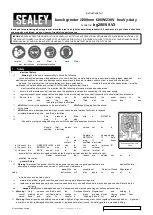
14 • ENGLISH
ADDITIONAL SAFETY WARNINGS
SPECIFIC FOR ABRASIVE
CUTTING-OFF OPERATIONS
f
Do not “jam” the cut-off wheel or apply excessive
pressure. Do not attempt to make an excessive
depth of cut. Over stressing the wheel increases
the loading and susceptibility to twisting or binding
of the wheel in the cut and the possibility of kickback
or wheel breakage.
f
Do not position your body in line with and behind
the rotating wheel. When the wheel, at the point
of operation, is moving away from your body, the
possible kickback may propel the spinning wheel
and the power tool directly at you.
f
When wheel is binding or when interrupting a cut
for any reason, switch off the power tool and hold
the power tool motionless until the wheel comes
to a complete stop. Never attempt to remove the
cut-off wheel from the cut while the wheel is in
motion otherwise kickback may occur. Investigate
and take corrective action to eliminate the cause of
wheel binding.
f
Do not restart the cutting operation in the
workpiece. Let the wheel reach full speed and
carefully re-enter the cut. The wheel may bind,
walk up or kickback if the power tool is restarted
in the workpiece.
f
Support panels or any oversized workpiece to
minimize the risk of wheel pinching and kickback.
Large workpieces tend to sag under their own weight.
Supports must be placed under the workpiece near
the line of cut and near the edge of the workpiece on
both sides of the wheel.
f
Use extra caution when making a “pocket cut”
into existing walls or other blind areas. The
protruding wheel may cut gas or water pipes,
electrical wiring or objects that can cause kickback.
Safety warnings specific for sanding operations
f
Do not use excessively oversized sanding disc
paper. Follow manufacturers recommendations,
when selecting sanding paper. Larger sanding
paper extending beyond the sanding pad presents a
laceration hazard and may cause snagging, tearing
of the disc or kickback.
Safety warnings specific for polishing
operations
f
Do not allow any loose portion of the polishing
bonnet or its attachment strings to spin freely.
Tuck away or trim any loose attachment strings.
Loose and spinning attachment strings can entangle
your fingers or snag on the workpiece.
Safety warnings specific for wire brushing
operations
f
Be aware that wire bristles are thrown by the
brush even during ordinary operation. Do not
overstress the wires by applying excessive load
to the brush. The wire bristles can easily penetrate
light clothing and/or skin.
f
If the use of a guard is recommended for wire
brushing, do not allow any interference of the
wire wheel or brush with the guard. Wire wheel
or brush may expand in diameter due to work load
and centrifugal forces.
Safety of others
f
This appliance is not intended for use by persons
(including children) with reduced physical, sensory
or mental capabilities, or lack of experience and
knowledge, unless they have been given supervision
or instruction concerning use of the appliance
by a person responsible for their safety.
f
Children should be supervised to ensure that they
do not play with the appliance.
Residual risks.
Additional residual risks may arise when using the
tool which may not be included in the enclosed safety
warnings. These risks can arise from misuse, prolonged
use etc. Even with the application of the relevant safety
regulations and the implementation of safety devices,
certain residual risks can not be avoided. These include:
f
Injuries caused by touching any rotating/moving parts.
f
Injuries caused when changing any parts, blades
or accessories.
f
Injuries caused by prolonged use of a tool. When
using any tool for prolonged periods ensure you take
regular breaks.
f
Impairment of hearing.
f
Health hazards caused by breathing dust developed
when using your tool (example:- working with wood,
especially oak, beech and MDF.)
Vibration
The declared vibration emission values stated in the
technical data and the declaration of conformity have been
measured in accordance with a standard test method
provided by EN 60745 and may be used for comparing
one tool with another. The declared vibration emission
value may also be used in a preliminary assessment of
exposure.
Warning! The vibration emission value during actual
use of the power tool can differ from the declared value
depending on the ways in which the tool is used. The
vibration level may increase above the level stated.
Содержание STEL845
Страница 3: ...FIG F 14 17 16 11 6...


































